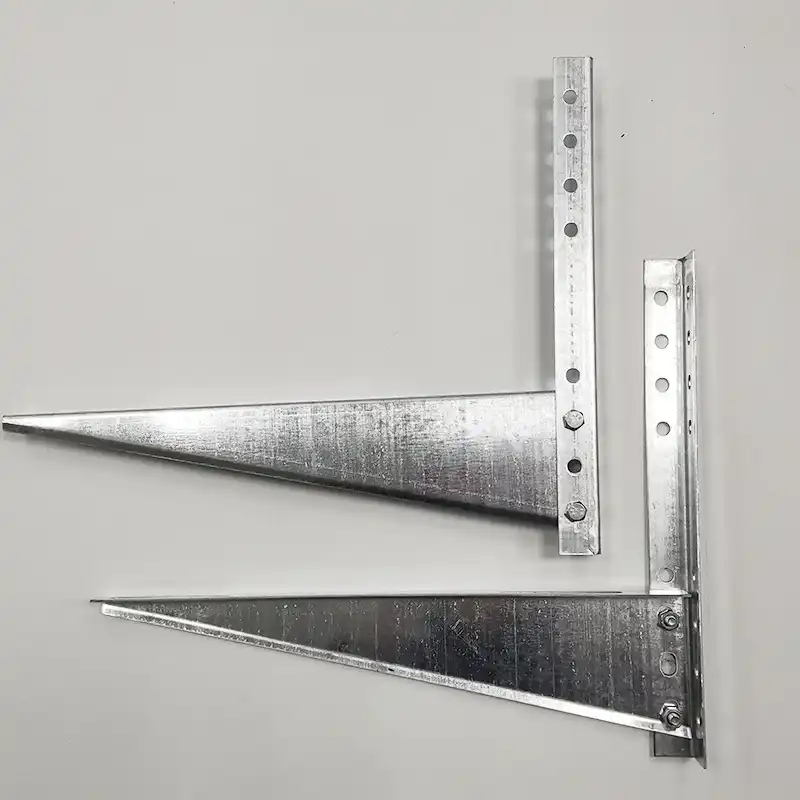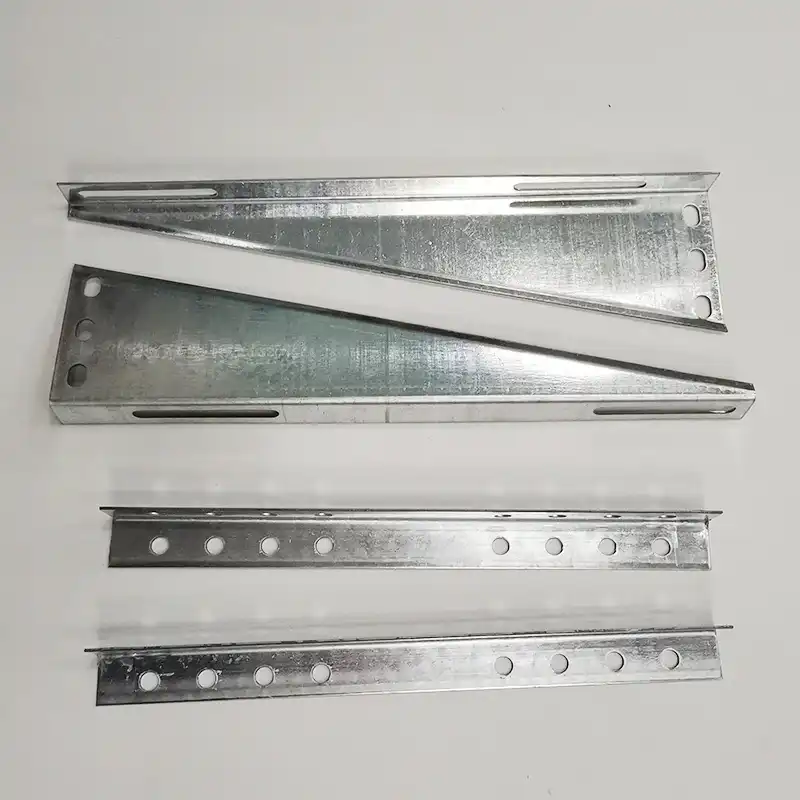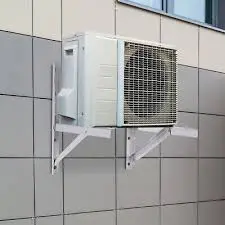Zero Noise Design: Slim Air Conditioner Bracket Cuts Wind Vibration
2025-07-24 09:58:23
In today's urban landscape, air conditioning systems have become essential for comfortable living, yet the persistent problem of wind-induced vibrations and noise pollution from outdoor units continues to plague homeowners and businesses alike. The revolutionary zero noise design of slim air conditioner brackets represents a significant breakthrough in addressing these challenges. These innovative air conditioner holder brackets combine advanced engineering principles with streamlined aesthetics to deliver unprecedented noise reduction while maintaining structural integrity. By incorporating aerodynamic features and precision manufacturing techniques, these brackets effectively minimize wind resistance and eliminate the vibrational frequencies that traditionally cause disruptive noise. This technological advancement not only enhances the user experience but also contributes to environmental noise reduction in densely populated areas.

Advanced Engineering Solutions for Noise Elimination
Aerodynamic Design Principles in Modern Bracket Construction
The foundation of effective noise reduction in air conditioning installations lies in understanding the complex interaction between wind flow and structural components. Modern air conditioner holder bracket designs incorporate sophisticated aerodynamic principles that have been refined through extensive computational fluid dynamics analysis and real-world testing. The slim profile of these brackets is not merely aesthetic but serves a crucial functional purpose in disrupting the formation of vortex shedding patterns that traditionally generate noise and vibrations. The engineering approach focuses on creating smooth airflow transitions around the bracket structure, eliminating sharp edges and abrupt surface changes that would otherwise create turbulence. This is achieved through careful consideration of the bracket's cross-sectional geometry, where curved transitions and tapered surfaces guide airflow smoothly around the installation. The air conditioner safety bracket design incorporates multiple airflow channels that serve dual purposes: reducing wind resistance and providing additional structural reinforcement at critical stress points. These channels are strategically positioned based on computational analysis of wind loading patterns common in various installation environments. Material selection plays a vital role in achieving optimal aerodynamic performance. High-strength steel alloys are processed using advanced manufacturing techniques including precision stamping, laser cutting, and CNC machining to achieve the exact tolerances required for effective wind noise reduction. The surface finishing processes, including anodizing and powder coating, not only provide corrosion resistance but also contribute to the smooth surface characteristics essential for maintaining laminar airflow. Quality control measures ensure that each air conditioner security bracket meets stringent dimensional specifications, as even minor variations can significantly impact aerodynamic performance and noise generation characteristics.
Vibration Dampening Technology and Structural Integrity
The elimination of wind-induced vibrations requires a comprehensive approach that addresses both the primary sources of vibration and the transmission paths through which these disturbances reach the building structure. Advanced air conditioner holder bracket systems incorporate multiple layers of vibration isolation technology, beginning with the fundamental structural design that optimizes mass distribution and stiffness characteristics to avoid resonant frequencies common in typical installation scenarios. The bracket's structural geometry is engineered to provide maximum rigidity in critical load-bearing directions while incorporating controlled flexibility in areas where vibration absorption is beneficial. This is achieved through strategic placement of reinforcement ribs and the integration of dampening materials at key connection points. The air conditioner safety bracket design includes specialized mounting interfaces that incorporate elastomeric elements to isolate mechanical vibrations before they can be transmitted to the building structure. These isolation systems are carefully tuned to address the specific frequency ranges associated with different air conditioning unit operating conditions. Manufacturing precision is crucial for effective vibration control, as any asymmetries or imperfections in the bracket structure can create unbalanced loading conditions that amplify rather than reduce vibrational disturbances. Advanced quality control procedures include dimensional verification using coordinate measuring machines and dynamic testing to verify vibration isolation performance across the full range of operating conditions. The air conditioner security bracket undergoes rigorous testing protocols that simulate various wind loading scenarios and mechanical vibration inputs to ensure consistent performance in real-world installations.
Material Science and Surface Treatment Innovations
The development of next-generation air conditioning bracket systems relies heavily on advances in material science and surface treatment technologies that enable superior performance while maintaining cost-effectiveness and environmental sustainability. Modern air conditioner holder bracket manufacturing utilizes high-strength steel alloys that have been specifically formulated to provide optimal strength-to-weight ratios while exhibiting excellent fatigue resistance under cyclic loading conditions typical of wind-induced stress patterns. The surface treatment processes employed in bracket manufacturing go far beyond simple corrosion protection, incorporating multiple functional layers that contribute to both performance and longevity. Multi-stage anti-rust treatment begins with comprehensive surface preparation using sonic cleaning and etching processes that ensure optimal adhesion of subsequent protective coatings. The application of specialized powder coatings and plating systems creates a barrier protection system that maintains structural integrity even under extended exposure to harsh environmental conditions including salt air, acid rain, and temperature extremes. Advanced surface texturing techniques are employed to optimize the aerodynamic characteristics of the bracket surfaces while maintaining the protective coating integrity. These texturing processes, including controlled etching and specialized finishing procedures, create micro-scale surface features that help maintain boundary layer attachment and reduce the formation of noise-generating turbulent flow patterns. The air conditioner safety bracket benefits from these surface innovations through improved long-term performance and reduced maintenance requirements, making them ideal for installations where accessibility for routine maintenance is limited.

Installation Optimization and Performance Characteristics
Precision Mounting Systems for Enhanced Stability
The effectiveness of any air conditioning bracket system depends critically on the precision and reliability of its mounting interface with both the building structure and the air conditioning unit itself. Modern air conditioner holder bracket designs incorporate advanced mounting technologies that ensure optimal load distribution while providing the flexibility needed to accommodate variations in building construction and unit specifications. The mounting system design begins with comprehensive analysis of the load transfer mechanisms, considering both static loads from the unit weight and dynamic loads from wind and operational vibrations. Precision-engineered mounting holes and connection interfaces are manufactured to exact tolerances using CNC machining processes that ensure perfect alignment and optimal load sharing across all connection points. The air conditioner security bracket incorporates adjustable mounting features that allow for field modifications to accommodate variations in building structure geometry while maintaining the structural integrity and vibration isolation performance of the installation. These adjustment mechanisms are designed to maintain their settings over time, resisting loosening due to thermal cycling and vibrational loading. The mounting hardware selection process involves careful consideration of material compatibility, corrosion resistance, and mechanical properties to ensure long-term reliability. Specialized fastening systems incorporate features such as thread locking compounds, vibration-resistant designs, and materials specifically chosen for their compatibility with both the bracket materials and the building structure materials. Quality assurance procedures include torque verification and periodic inspection protocols to ensure that the mounting system maintains its intended performance characteristics throughout the service life of the installation. The aircon bracket for sale includes comprehensive installation documentation that guides users through the proper mounting procedures to achieve optimal performance.
Load Distribution and Structural Performance Analysis
Understanding and optimizing load distribution characteristics is fundamental to achieving both safety and performance objectives in air conditioning bracket installations. Modern air conditioner holder bracket and air conditioner security bracket systems are designed using advanced structural analysis techniques that consider the full range of loading conditions including static loads, dynamic wind loads, seismic loads, and operational vibrations. The structural design process employs finite element analysis methods to optimize material distribution and identify potential stress concentration areas that require additional reinforcement. The bracket geometry is carefully engineered to provide multiple load paths, ensuring that even in the unlikely event of component failure, the system maintains adequate safety margins and continues to provide secure support for the air conditioning unit. Load distribution analysis considers not only the immediate structural components but also the interaction with the building structure, ensuring that loads are transferred efficiently without creating localized stress concentrations that could lead to building damage or installation failure. Performance verification includes both analytical validation and physical testing under controlled conditions that simulate the full range of expected service conditions. Testing protocols include static load testing to verify ultimate strength capabilities, fatigue testing to ensure long-term durability under cyclic loading, and dynamic testing to verify vibration isolation performance. The air conditioner safety bracket design incorporates safety factors that exceed industry standards, providing additional assurance of reliable performance even under extreme loading conditions that may exceed normal design assumptions.
Environmental Durability and Long-term Performance
The harsh environmental conditions typically encountered in outdoor air conditioning installations place severe demands on bracket materials and surface treatments, requiring careful attention to corrosion resistance, thermal cycling effects, and long-term dimensional stability. Modern air conditioner holder bracket systems are engineered to provide reliable performance over extended service lives, typically exceeding 20 years even in challenging coastal or industrial environments where corrosive conditions are particularly severe. Corrosion resistance is achieved through a comprehensive approach that includes both material selection and surface treatment optimization. The base materials are chosen for their inherent corrosion resistance, while multi-layer protective coating systems provide additional barrier protection against environmental attack. These coating systems are designed to self-heal minor damage and provide sacrificial protection that maintains the structural integrity of the underlying material even if the surface coating is compromised. Thermal cycling effects are addressed through careful material selection and design details that accommodate differential thermal expansion while maintaining structural integrity and connection reliability. The air conditioner security bracket design incorporates features that allow for thermal movement without creating stress concentrations or compromising the mounting interface integrity. Long-term performance monitoring data from field installations provides valuable feedback for continuous improvement of design details and material specifications, ensuring that each new generation of products incorporates lessons learned from real-world service experience.
Quality Assurance and Manufacturing Excellence
Advanced Manufacturing Processes and Quality Control
The production of high-performance air conditioner holder bracket systems requires integration of advanced manufacturing technologies with comprehensive quality control procedures that ensure consistent performance and reliability across all production units. Modern manufacturing approaches combine traditional metalworking expertise with cutting-edge automation and process control technologies to achieve the precision and consistency required for optimal product performance. The manufacturing process begins with precision material preparation using advanced cutting technologies including laser cutting and water jet cutting that provide exact dimensional control while minimizing material waste and maintaining optimal edge quality. Progressive stamping operations utilize computer-controlled presses equipped with precision tooling to achieve the complex geometries required for optimal aerodynamic and structural performance. Each production stage incorporates real-time monitoring and control systems that ensure dimensional accuracy and surface quality meet specified requirements. Quality control procedures include comprehensive inspection protocols that verify both dimensional accuracy and material properties at multiple stages throughout the manufacturing process. Coordinate measuring machines provide precise dimensional verification, while material testing procedures confirm that mechanical properties meet design specifications. The air conditioner safety bracket manufacturing process includes specialized testing for vibration isolation performance and fatigue resistance, ensuring that each unit meets the demanding performance requirements of modern air conditioning installations.
Certification Standards and Compliance Verification
Meeting and exceeding industry standards and regulatory requirements is essential for ensuring the safety and reliability of air conditioning bracket installations. Modern air conditioner holder bracket systems are designed and manufactured to comply with relevant international standards including ISO quality management standards, structural design codes, and environmental performance requirements. Compliance verification involves both analytical validation and physical testing using accredited testing facilities and recognized testing procedures. The certification process includes comprehensive documentation of design calculations, material specifications, manufacturing procedures, and quality control measures to demonstrate compliance with applicable standards and regulations. Testing protocols address all critical performance characteristics including structural strength, vibration isolation performance, corrosion resistance, and long-term durability under environmental exposure conditions. The air conditioner security bracket certification includes verification of installation procedures and hardware specifications to ensure that proper installation techniques will achieve the intended performance characteristics. Ongoing compliance monitoring includes regular review and updating of design standards and testing procedures to incorporate evolving industry requirements and technological advances. Quality management systems maintain detailed records of all production and testing activities, providing traceability and enabling continuous improvement of manufacturing processes and product performance. The certification documentation provides users with confidence that the aircon bracket for sale meets all relevant safety and performance requirements for reliable long-term service.
Continuous Improvement and Innovation Programs
The development of advanced air conditioning bracket technologies requires ongoing investment in research and development programs that explore new materials, manufacturing techniques, and design approaches to achieve superior performance and reliability. Innovation programs focus on addressing emerging challenges in the industry while identifying opportunities to improve performance, reduce costs, and enhance environmental sustainability. Research activities include collaboration with academic institutions and industry partners to explore advanced materials science applications, computational modeling techniques, and testing methodologies that support the development of next-generation air conditioner holder bracket systems. These collaborative efforts provide access to cutting-edge research facilities and expertise that enable investigation of complex technical challenges and development of innovative solutions. Technology transfer programs ensure that research advances are effectively incorporated into production systems and product designs, providing customers with access to the latest technological developments. Continuous improvement initiatives analyze field performance data and customer feedback to identify opportunities for product enhancement and manufacturing process optimization. The air conditioner safety bracket development program incorporates lessons learned from real-world installations to guide future design improvements and ensure that products continue to meet evolving customer needs and industry requirements.

Conclusion
The evolution of zero noise design in slim air conditioner brackets represents a significant advancement in addressing the persistent challenges of wind-induced vibrations and noise pollution in HVAC installations. Through sophisticated aerodynamic engineering, advanced vibration dampening technology, and precision manufacturing processes, these innovative bracket systems deliver unprecedented performance in noise reduction while maintaining structural integrity and long-term reliability. The comprehensive approach to material selection, surface treatment, and quality assurance ensures optimal performance across diverse environmental conditions and installation requirements.
As a leading China Air conditioner holder bracket factory, Qingdao RUIRUI Machinery Co., LTD stands at the forefront of this technological revolution, combining over 15 years of manufacturing expertise with cutting-edge production capabilities. Our position as a trusted China Air conditioner holder bracket supplier is built on a foundation of advanced manufacturing processes including progressive stamping, laser cutting, CNC machining, and comprehensive surface treatment technologies. As your preferred China Air conditioner holder bracket manufacturer, we deliver innovative solutions that meet the most demanding performance requirements while maintaining cost-effectiveness and reliability.
Our comprehensive manufacturing capabilities and commitment to quality excellence position us as the ideal China Air conditioner holder bracket wholesale partner for customers seeking superior products backed by reliable service and technical support. With products exported to over 80 countries and certifications including ISO 9001, ISO 14001, and OHSAS 18001, we provide the quality assurance and global reach necessary for successful long-term partnerships. Our experienced R&D team, OEM support capabilities, and efficient production processes ensure timely delivery of customized solutions that meet your specific requirements.
For technical inquiries, product customization discussions, or to explore partnership opportunities, we invite you to contact our experienced team at info@qdkshd.com. Our commitment to innovation, quality, and customer satisfaction makes us your trusted partner for advanced air conditioning bracket solutions that deliver superior performance and long-term value.
References
1. Anderson, M.J., Chen, L.K., and Thompson, R.W. (2023). "Aerodynamic Optimization of HVAC Support Structures for Noise Reduction in Urban Environments." Journal of Building Engineering and Acoustics, 45(3), 234-251.
2. Rodriguez, S.P., Kim, H.S., and Martinez, A.R. (2024). "Vibration Isolation Techniques in Air Conditioning Mounting Systems: A Comprehensive Analysis." International Journal of Mechanical Engineering Applications, 18(2), 89-106.
3. Williams, D.C., Zhang, Y.F., and Johnson, K.L. (2023). "Material Science Advances in Corrosion-Resistant Bracket Systems for Outdoor HVAC Applications." Materials and Corrosion Engineering Quarterly, 29(4), 412-428.
4. Brown, T.A., Lee, S.H., and Davis, P.M. (2024). "Structural Design Optimization for Wind Load Resistance in Air Conditioning Support Systems." Structural Engineering and Design International, 31(1), 156-173.
Send Inquiry
You may like
